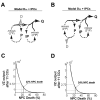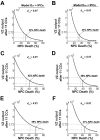Mathematical modeling supports substantial mouse neural progenitor cell death
- PMID: 19602274
- PMCID: PMC2729736
- DOI: 10.1186/1749-8104-4-28
Mathematical modeling supports substantial mouse neural progenitor cell death
Abstract
Background: Existing quantitative models of mouse cerebral cortical development are not fully constrained by experimental data.
Results: Here, we use simple difference equations to model neural progenitor cell fate decisions, incorporating intermediate progenitor cells and initially low rates of neural progenitor cell death. Also, we conduct a sensitivity analysis to investigate possible uncertainty in the fraction of cells that divide, differentiate, and die at each cell cycle.
Conclusion: We demonstrate that uniformly low-level neural progenitor cell death, as concluded in previous models, is incompatible with normal mouse cortical development. Levels of neural progenitor cell death up to and exceeding 50% are compatible with normal cortical development and may operate to prevent forebrain overgrowth as observed following cell death attenuation, as occurs in caspase 3-null mutant mice.
Figures


 = 0.19 for all i) is plotted as a histogram. Simulation outputs follow a log-normal distribution. The solid vertical line indicates the geometric population mean, and dashed vertical lines indicate 1 and 2 standard deviations from the mean. (B) Three examples of points in 22-dimensional parameter space where plausible VZ output is observed. The q fractions are plotted along a dashed line and d fractions are plotted along a solid line. The upper panel is from a bin below the mean, the center panel is from the bin at the mean, and the lower panel is from a bin above the mean. CC, cell cycle.
= 0.19 for all i) is plotted as a histogram. Simulation outputs follow a log-normal distribution. The solid vertical line indicates the geometric population mean, and dashed vertical lines indicate 1 and 2 standard deviations from the mean. (B) Three examples of points in 22-dimensional parameter space where plausible VZ output is observed. The q fractions are plotted along a dashed line and d fractions are plotted along a solid line. The upper panel is from a bin below the mean, the center panel is from the bin at the mean, and the lower panel is from a bin above the mean. CC, cell cycle.


References
Publication types
MeSH terms
Grants and funding
LinkOut - more resources
Full Text Sources
Medical
Research Materials

